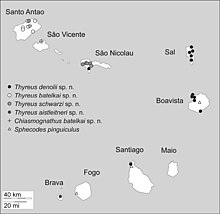Thyreus denolii
It belongs to the tribe Melectini and to the genus Thyreus, the members of which are often referred to as 'Cuckoo bees', due to their parasitic behaviour.
[1] The species was first described in 2012, and was named after the Genoese navigator António de Noli, who after being exiled from his home country discovered the Cape Verde Islands around 1456 while he was working for Portugal.
[1] Thyreus denolli has been recorded in the islands of Sal, Boa Vista, Santiago, and possibly São Nicolau, in Cape Verde.
[1] Despite their relative isolation from each other, the species of T. denolii across Sal, Boavista, and Santiago do not seem to show any significant difference in appearance or morphology.
[1] The primary hosts of T. denolii and the other three members of Thyreus in Cape Verde are bees in the genus Amegilla, with which it is commonly associated in the field.

